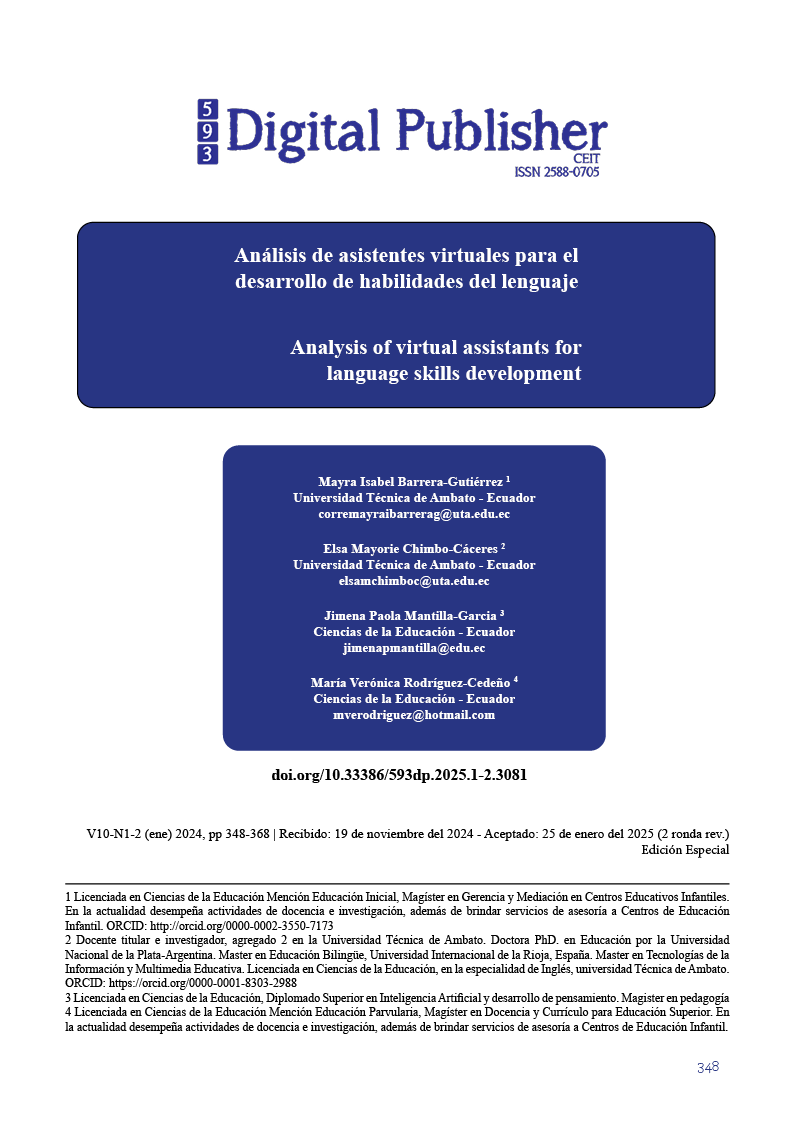Análisis de asistentes virtuales para el desarrollo de habilidades del lenguaje
Contenido principal del artículo
Resumen
El análisis de la efectividad de los asistentes virtuales en el desarrollo de habilidades lingüísticas mostró que estas herramientas son especialmente beneficiosas para los estudiantes principiantes, quienes experimentaron mejoras significativas en áreas como pronunciación y comprensión auditiva. Los principiantes también fueron los que más utilizaron los asistentes, lo que sugiere que la retroalimentación inmediata y la práctica constante son elementos clave para su aprendizaje. En el caso de los estudiantes intermedios, aunque se observaron mejoras, la falta de desafíos adecuados en las actividades ofrecidas redujo su motivación y frecuencia de uso. Por otro lado, los estudiantes avanzados, aunque mostraron puntuaciones altas desde el inicio, experimentaron mejoras limitadas debido a la falta de contenido complejo y desafiante, lo que resultó en una menor participación. Estos resultados destacan la necesidad de personalización en los asistentes virtuales, especialmente para los niveles intermedios y avanzados, quienes requieren tareas más adaptadas a sus necesidades y habilidades específicas.
Descargas
Detalles del artículo

Esta obra está bajo una licencia internacional Creative Commons Atribución-NoComercial-CompartirIgual 4.0.
1. Derechos de autor
Las obras que se publican en 593 Digital Publisher CEIT están sujetas a los siguientes términos:
1.1. 593 Digital Publisher CEIT, conserva los derechos patrimoniales (copyright) de las obras publicadas, favorece y permite la reutilización de las mismas bajo la licencia Licencia Creative Commons 4.0 de Reconocimiento-NoComercial-CompartirIgual 4.0, por lo cual se pueden copiar, usar, difundir, transmitir y exponer públicamente, siempre que:
1.1.a. Se cite la autoría y fuente original de su publicación (revista, editorial, URL).
1.1.b. No se usen para fines comerciales u onerosos.
1.1.c. Se mencione la existencia y especificaciones de esta licencia de uso.
Citas
Afshar, M., Zarei, A., Moghaddam, M. R., & Shoorei, H. (2024). Flipped and Peer-Assisted teaching: a new model in virtual anatomy education. BMC Medical Education, 24(1), 722. https://doi.org/10.1186/s12909-024-05697-4
Albadarin, Y., Saqr, M., Pope, N., & Tukiainen, M. (2024). A systematic literature review of empirical research on ChatGPT in education. Discover Education, 3(1), 60. https://doi.org/10.1007/s44217-024-00138-2
Anton, C. E., Ciobanu, E., Brătucu, G., & Bucs, L. (2024). Using Chatbots to Enhance Integrated Reporting: Insights from Accounting and Consultancy Companies from Romania. Electronics (Switzerland), 13(23), 4801. https://doi.org/10.3390/electronics13234801
Barulina, E., Nguyen, D. Du, Shuklin, F., Podobrii, M., Novikov, S., Chernov, A., Kim, I., & Barulin, A. (2024). Dual-Wavelength On-Chip Integrated Metalens for Epi-Fluorescence Single-Molecule Sensing. Sensors, 24(23), 7781. https://doi.org/10.3390/s24237781
Belosevic, M., & Buschmeier, H. (2024). Quote to Explain: Using Multimodal Metalinguistic Markers to Explain Large Language Models’ Understanding Capabilities. ACM International Conference Proceeding Series, 225–227. https://doi.org/10.1145/3686215.3689203
Cascella, M., Semeraro, F., Montomoli, J., Bellini, V., Piazza, O., & Bignami, E. (2024). The Breakthrough of Large Language Models Release for Medical Applications: 1-Year Timeline and Perspectives. Journal of Medical Systems, 48(1), 22. https://doi.org/10.1007/s10916-024-02045-3
Du, K., Zhao, Y., Mao, R., Xing, F., & Cambria, E. (2025). Natural language processing in finance: A survey. Information Fusion, 115, 102755. https://doi.org/10.1016/j.inffus.2024.102755
Elsayed, A. A., Hafez, A. I., Ceprián, R., Martínez, G., Granados, A., Soriano, B., Llorens, C., & Sempere, J. M. (2024). Practical Design and Implementation of Virtual Chatbot Assistants for Bioinformatics Based on a NLU Open Framework. Big Data and Cognitive Computing, 8(11), 163. https://doi.org/10.3390/bdcc8110163
Goodhart, A. L., & Momen, J. (2025). Improving chronic care management through asynchronous telehealth simulations. Journal of Interprofessional Education and Practice, 38, 100736. https://doi.org/10.1016/j.xjep.2024.100736
Ieva, S., Loconte, D., Loseto, G., Ruta, M., Scioscia, F., Marche, D., & Notarnicola, M. (2024). A Retrieval-Augmented Generation Approach for Data-Driven Energy Infrastructure Digital Twins. Smart Cities, 7(6), 3095–3120. https://doi.org/10.3390/smartcities7060121
Isiaku, L., Muhammad, A. S., Kefas, H. I., & Ukaegbu, F. C. (2024). Enhancing technological sustainability in academia: leveraging ChatGPT for teaching, learning and evaluation. Quality Education for All, 1(1), 385–416. https://doi.org/10.1108/QEA-07-2024-0055
Kang, N. H. (2019). A review of the effect of integrated STEM or STEAM (science, technology, engineering, arts, and mathematics) education in South Korea. Asia-Pacific Science Education, 5(1), 1–22. https://doi.org/10.1186/s41029-019-0034-y
Khan, A., & Ali, R. (2024). Unraveling minds in the digital era: a review on mapping mental health disorders through machine learning techniques using online social media. Social Network Analysis and Mining, 14(1), 78. https://doi.org/10.1007/s13278-024-01205-0
Lilley, K. D., Dossey, E., Cohn, M., Clopper, C. G., Wagner, L., & Zellou, G. (2025). Social evaluation of text-to-speech voices by adults and children. Speech Communication, 166, 103163. https://doi.org/10.1016/j.specom.2024.103163
Lo, C. K., Hew, K. F., & Chen, G. (2017). Toward a set of design principles for mathematics flipped classrooms: A synthesis of research in mathematics education. Educational Research Review, 22, 50–73. https://doi.org/10.1016/j.edurev.2017.08.002
Lufler, R. S., Saini, H., Cardamone, C., & Marchant, J. K. (2024). The Synergy of Cadaver-Based and Virtual Education: Comparing Learning Outcomes in a Physician Assistant Clinical Anatomy Course. Journal of Physician Assistant Education, 35(4), 391–396. https://doi.org/10.1097/JPA.0000000000000616
Luo, D. (2024). Design and Implementation of Virtual Reality Emotion Induction System. ACM International Conference Proceeding Series, 1–5. https://doi.org/10.1145/3700035.3700036
Mahto, M. K., & Rajavikram, G. (2024). Fundamentals of AI and communication networks: Applications in human social activities. In Intelligent Networks: Techniques, and Applications (pp. 1–17). CRC Press. https://doi.org/10.1201/9781003541363-1
Manisha, Kumar, A., & Yadav, D. K. (2025). Analytical Insight into Cutting-Edge Image Captioning for Advanced ChatGPT Functionality. Communications in Computer and Information Science, 2358, 221–235. https://doi.org/10.1007/978-3-031-80778-7_16
Mazhar, T., Shah, S. F. A., Inam, S. A., Awotunde, J. B., Saeed, M. M., & Hamam, H. (2024). Analysis of integration of IoMT with blockchain: issues, challenges and solutions. Discover Internet of Things, 4(1), 21. https://doi.org/10.1007/s43926-024-00078-1
McKennon, S. A., Sandum, T. K., & Willson, M. N. (2024). The impact of a microaggressions-themed interprofessional education curriculum on attitudes, confidence, and collaboration competencies: A curricular resource for health professions learners. Journal of Interprofessional Education and Practice, 37, 100726. https://doi.org/10.1016/j.xjep.2024.100726
Nouzri, S., EL Fatimi, M., Guerin, T., Othmane, M., & Najjar, A. (2025). Beyond Chatbots: Enhancing Luxembourgish Language Learning Through Multi-agent Systems and Large Language Model. Lecture Notes in Computer Science (Including Subseries Lecture Notes in Artificial Intelligence and Lecture Notes in Bioinformatics) , 15395, 385–401. https://doi.org/10.1007/978-3-031-77367-9_29
Park, C., Jeong, S., & Kim, J. (2024). MaQA: A Manual Text-Based Approach for Car-Specific Question Answering. Electronics (Switzerland), 13(24), 4972. https://doi.org/10.3390/electronics13244972
Park, S., Menassa, C. C., & Kamat, V. R. (2025). Integrating Large Language Models with Multimodal Virtual Reality Interfaces to Support Collaborative Human-Robot Construction Work. Journal of Computing in Civil Engineering, 39(1), 04024053. https://doi.org/10.1061/JCCEE5.CPENG-6106
Parra, M. O., Favela, J., Castro, L. A., & Gatica-Perez, D. (2024). Towards Wine Tasting Activity Recognition for a Digital Sommelier. ACM International Conference Proceeding Series, 108–112. https://doi.org/10.1145/3686215.3686217
Pfeiffer, D. L., Thompson, A., Ciullo, B., Hirsch, M. E., El Amin, M., Ford, A., Riccardi, J., & Kearney, E. (2025). “1-800-Help-Me-With-Open-Science-Stuff”: A Qualitative Examination of Open Science Practices in Communication Sciences and Disorders. Journal of Speech, Language, and Hearing Research : JSLHR, 68(1), 105–128. https://doi.org/10.1044/2024_JSLHR-24-00378
Plitman, E., Kim, E., Patel, R., Kohout, S., Jin, R., Chan, V., & Dinsmore, M. (2024). Development of an Automated and Scalable Virtual Assistant to Aid in PPE Adherence: A Study with Implications for Applications within Anesthesiology. Journal of Medical Systems, 48(1), 7. https://doi.org/10.1007/s10916-023-02028-w
Pousada, M., Guillamón, N., Hernández-Encuentra, E., Muñoz, E., Redolar, D., Boixadós, M., Gómez-Zúñiga, B., & Gómez-Zúñiga, B. (2013). Impact of caring for a child with cerebral palsy on the quality of life of parents: a systematic review of the literature. Springer, 25, 545–577. https://doi.org/10.1007/s10882-013-9332-6
Prakash, V., Foster, A. L., Noble, J., & Zaiane, O. R. (2025). Integrating Conversational Pathways with a Chatbot Builder Platform. Lecture Notes in Computer Science (Including Subseries Lecture Notes in Artificial Intelligence and Lecture Notes in Bioinformatics) , 15343, 184–189. https://doi.org/10.1007/978-3-031-78093-6_15
Review, S. N.-N., & 2021, undefined. (n.d.). Basal Ganglia and Thalamic Contributions to Language Function: Insights from A Parallel Distributed Processing Perspective. Springer. Retrieved December 25, 2021, from https://idp.springer.com/authorize/casa?redirect_uri=https://link.springer.com/article/10.1007/s11065-020-09466-0&casa_token=3qa9FYY3oBUAAAAA:eqwD-OQTumBEJNgoa6YmD_OAf37JsNyvbPNsmi8ZFnoCLR_eKcIv7eeE0rQMeNygn21jyHVedKbIeHdyeA
Rosa, J. P. P. (2025). The potential role of artificial intelligence to promote the participation and inclusion in physical exercise and sports for people with disabilities: A narrative review. Journal of Bodywork and Movement Therapies, 42, 127–131. https://doi.org/10.1016/j.jbmt.2024.12.024
Rosas, M. (2024). “God Save Me from a Civilized Indian”: Labor Union Schools and Contending Visions for Indigenous Education in Ecuador, 1936–1963. HAHR - Hispanic American Historical Review, 104(3), 465–495. https://doi.org/10.1215/00182168-11189972
Sabic, I., Puljiz, H., & Smoljo, A. (2024). Personalized Learning in the Croatian National Education System: A Study of AI Implementation in the e-Class Register. SN Computer Science, 5(8), 1145. https://doi.org/10.1007/s42979-024-03515-8
Setayeshi, R., Vahidi, J., Kozegar, E., & Tan, T. (2024). An end-to-end multi-task deep learning framework for bronchoscopy image classification. Multimedia Systems, 30(6), 361. https://doi.org/10.1007/s00530-024-01579-3
Shah, M., Pankiewicz, M., Baker, R. S., Chi, J., Xin, Y., Shah, H., & Fonseca, D. (2025). Students’ Use of an LLM-Powered Virtual Teaching Assistant for Recommending Educational Applications of Games. Lecture Notes in Computer Science (Including Subseries Lecture Notes in Artificial Intelligence and Lecture Notes in Bioinformatics) , 15259, 19–24. https://doi.org/10.1007/978-3-031-74138-8_2
Singaravelan, A., & Hsu, J. L. (2025). Separating Party Conversation by Applying Contrastive Learning Methodology. Lecture Notes in Computer Science (Including Subseries Lecture Notes in Artificial Intelligence and Lecture Notes in Bioinformatics) , 15300, 264–276. https://doi.org/10.1007/978-3-031-78014-1_20
Toombs, A. L., Montague, K., Wong, R. Y., Brewer, R. N., Naik, S., Parsons, P. C., Šabanovic, S., & Whitley, D. (2024). Future Dialogues: Personal AI Assistants and Their Interactions with Us and Each Other. Proceedings of the ACM Conference on Computer Supported Cooperative Work, CSCW, 675–678. https://doi.org/10.1145/3678884.3687139
Velastegui, R., Poler, R., & Diaz-Madroñero, M. (2023). Conceptual model for scheduling and control of production and logistics operations using multi-agent robotic systems and blockchain. DYNA, 98(3), 307–313. https://doi.org/10.6036/10724
Velastegui, R., Poler, R., & Díaz-Madroñero, M. (2025). Revolutionising industrial operations: The synergy of multiagent robotic systems and blockchain technology in operations planning and control. Expert Systems with Applications, 269, 126460. https://doi.org/10.1016/J.ESWA.2025.126460
Velastegui-Hernández, R., Melo-Fiallos, D., Mayorga-Ases, M., Hernández-Del-Salto, S., Manobanda-Tenelema, E., & Garcia, M. V. (2024). Perceived Quality of Service in Tourist Transportation in the City of Baños de Agua Santa, Ecuador. Sustainability 2024, Vol. 16, Page 7245, 16(17), 7245. https://doi.org/10.3390/SU16177245
Xu, X., Luo, S., Yang, Y., Li, Y. L., & Lu, C. (2025). DISCO: Embodied Navigation and Interaction via Differentiable Scene Semantics and Dual-Level Control. Lecture Notes in Computer Science (Including Subseries Lecture Notes in Artificial Intelligence and Lecture Notes in Bioinformatics), 15076, 108–125. https://doi.org/10.1007/978-3-031-72649-1_7
Zhang, Z., Zhang, J., & Mai, W. (2025). VPT: Video portraits transformer for realistic talking face generation. Neural Networks, 184, 107122. https://doi.org/10.1016/j.neunet.2025.107122





